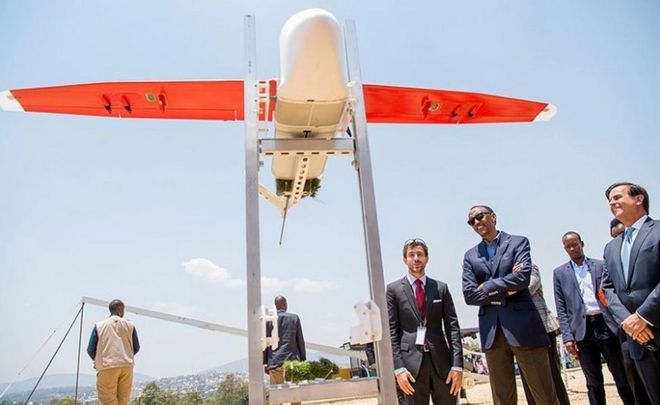-
29 December 2016
The UK government is to fund a trial of drone-based deliveries of blood and other medical supplies in Tanzania.
The goal is to radically reduce the amount of time it takes to send stock to health clinics in the African nation by road or other means.
The scheme involves Zipline, a Silicon Valley start-up that began running a similar service in Rwanda in October.
Experts praised that initiative but cautioned that “cargo drones” are still of limited use to humanitarian bodies.
The Department for International Development (Dfid) has not said how much money will be invested in the Tanzanian effort or for how long.
It also announced plans to fund tests of drones in Nepal to map areas of the country prone to damage from extreme weather, so help prepare for future crises.
“This innovative, modern approach ensures we are achieving the best results for the world’s poorest people and delivering value for money for British taxpayers,” commented the International Development Secretary Priti Patel.
Parachute deliveries
Zipline’s drones – called Zips – are small fixed-wing aircraft that are fired from a catapult and follow a pre-programmed path using GPS location data.
The advantage of the design over multi-rotor models is that the vehicles can better cope with windy conditions and stay airborne for longer. In theory, they can fly up to about 180 miles (290km) before running out of power, although Zipline tries to keep round trips to about half that distance.
Their drawback is that they require open space to land – in Zip’s case an area about the size of two car parking slots.
Zipline gets round this issue by having its drones descend to heights of about 5m (16.4ft) when they reach their destinations and then release their loads via paper parachutes. Afterwards, they regain altitude and return to base before coming to rest.
The aircraft fly below 500ft (152m) to avoid the airspace used by passenger planes.
Tanzania, Rwanda and Malawi – which uses a different type of drone for medical deliveries – all take a permissive approach to unmanned aerial vehicle [UAV] regulations, helping make them attractive places for such trials.
Earlier in the year, Tanzania also authorised the use of drones in its Tarangire National Park as part of an effort to deter animal poachers.
Saved lives
Dfid estimates that flying blood and medical supplies by drone from out of Tanzania’s capital, Dodoma, could save $58,000 (£47,400) a year compared to sending them by car or motorcycle.
But a spokeswoman suggested that the time savings were more crucial.
“Flights are planned to start in early 2017, and when they do it is estimated that [the] UAVs could support over 50,000 births a year, cutting down the time mothers and new-borns would have to wait for life-saving medicine to 19 minutes – reduced from the 110 minutes traditional transport methods would take,” she explained.
The Ifakara Health Institute – which specialises in treatments for malaria, HIV, tuberculosis as well as neonatal health issues – will be the local partner.The Humanitarian UAV Network and other non-profit bodies recently surveyed the use of drones to carry out human welfare tasks.
The study highlighted the work Zipline was doing, noting the firm was capable of setting up a new drones launch hub in as little as 24 hours, meaning it was well suited to rapid response efforts as well as longer-term projects.
But the study also noted that humanitarian cargos are often measured in tonnes rather than kilograms, and need to be transported across longer distances than a Zip can manage.
“Given these current trade-offs relative to manned aviation, the specific cases in which cargo drones can currently add value are particularly narrow in the context of the universe of needs that humanitarian organisations typically face,” it said.
And it added that more research was needed to properly evaluate whether existing schemes were as reliable as claimed.
“Organisations considering the use of cargo drones need statistics on flights performed, hours logged, failure rates and other performance measures.”
http://www.bbc.com/news/technology-38450664
